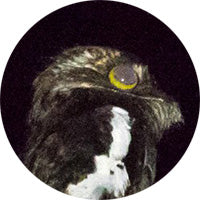White-winged Potoo
The White-winged Potoo (Nyctibius leucopterus) Read in Spanish
Appearance: The White-winged Potoo is a relatively large bird with cryptic plumage, which helps it blend in seamlessly with its surroundings. It has a mottled brown and grayish-white coloration to match tree bark and lichen-covered branches. Its most distinctive feature is its white wing patches, which are especially visible in flight.
Habitat: White-winged Potoos inhabit lowland forests, especially near rivers and streams. They prefer dense tropical forests and woodland areas where they can roost during the day, relying on their camouflage to stay hidden from predators.
Behavior: These birds are nocturnal, meaning they are most active during the night. They are expertly adapted to life in the dark, with large eyes designed to help them see well in low-light conditions. White-winged Potoos feed on insects, such as moths and beetles, which they catch in mid-air using their wide mouths.
Breeding: White-winged Potoos typically breed by laying one egg directly on a tree branch. The egg's cryptic coloration helps it blend in with the branch, providing camouflage and protection from predators. Both parents take turns incubating the egg, with the male often taking the day shift and the female the night shift.
Conservation Status: Because of their secretive nature and nocturnal habits, they can be challenging to study and monitor effectively. According to the Global IUCN 2023 it is of Least Concern.
Rich text
The White-winged Potoo (Nyctibius leucopterus)
Amazon Region: The White-winged Potoo is known to inhabit the Amazon region of Colombia, characterized by dense tropical rainforests and rich biodiversity. This area provides suitable habitat for the bird and supports a population of these elusive creatures.
Taxonomy
The Great Potoo (Nyctibius grandis)
- Kingdom: Animalia
- Phylum: Chordata
- Class: Aves (Birds)
- Order: Caprimulgiformes
- Family: Nyctibiidae
- Genus: Nyctibius
- Species: Nyctibius grandis
Vocalization
The White-winged Potoo (Nyctibius leucopterus)
- Song: The vocalizations of the White-winged Potoo consist of a series of haunting, eerie calls that are often described as a mournful wail or a high-pitched, descending "whinny." These vocalizations are typically heard during the breeding season and are used by males to establish territories and attract females.
- Timing: White-winged Potoos are nocturnal birds, meaning they are most active at night. Their vocalizations are primarily heard after dusk and before dawn when they are searching for mates, defending territories, or communicating with other birds in the vicinity.
- Frequency: The White-winged Potoo's vocalizations can vary in frequency and duration. They may repeat their calls at regular intervals, creating a rhythmic pattern that can carry over long distances through the forest canopy.
- Purpose: The vocalizations of the White-winged Potoo serve multiple purposes, including territorial defense, mate attraction, and communication between individuals. The unique sounds produced by these birds help them navigate their nocturnal world and interact with other members of their species.
- Variability: While the basic vocalizations of the White-winged Potoo are consistent across individuals, there may be variations in the calls and sounds produced by different birds. These variations can be influenced by factors such as age, sex, individual characteristics, and environmental conditions.




